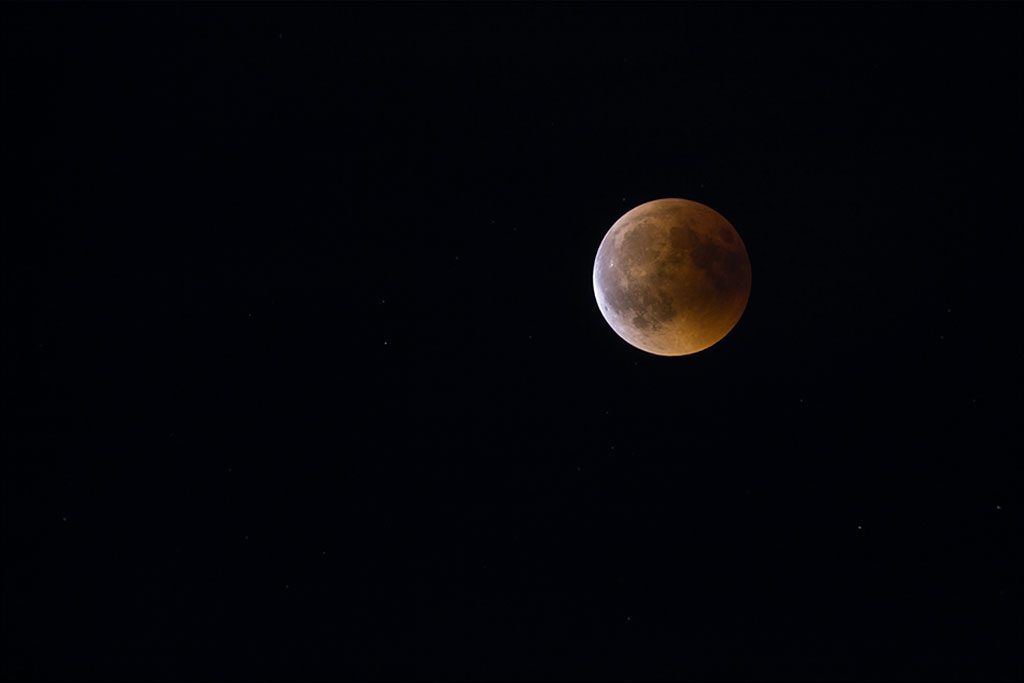"Tico tico no fubà"
Nombre total de pages vues
21/01/2019
Science & Technologie - Stelvision : Une belle éclipse totale de Lune le 21 janvier 2019
Une éclipse de Lune a lieu lorsque le Soleil, la Terre et notre satellite sont parfaitement alignés : la Lune se trouve alors dans l’ombre de la Terre. On pourrait croire qu’il est possible de voir une éclipse chaque mois au moment de la pleine lune, mais notre satellite circule sur une orbite inclinée de cinq degrés par rapport à celle de la Terre. La plupart du temps, notre satellite passe donc un peu au-dessus ou un peu au-dessous de l’alignement Soleil-Terre et il n’y a pas d’éclipse. La dernière éclipse totale visible en Europe remonte à juillet 2018 et la prochaine aura lieu en mai 2022.
Une éclipse totale de Lune dure plusieurs heures et comporte différentes phases. Les passages dans la pénombre de la Terre, en début et fin de phénomène, sont peu spectaculaires car la Lune reçoit encore une partie des rayons solaires : elle reste donc grise. Beaucoup plus intéressante, la période ou la Lune se trouve partiellement ou totalement dans l’ombre de notre planète doit retenir toute votre attention : c’est à ce moment que la Lune s’assombrit progressivement et change de couleur !
Une belle éclipse totale de Lune le 21 janvier 2019
Science & Technology - Astronomy picture of the day - 2019 January 21 : InSight Lander Takes Selfie on Mars

Image Credit: NASA/JPL-Caltech
Explanation: This is what NASA's Insight lander looks like on Mars. With its solar panels, InSight is about the size of a small bus. Insight successfully landed on Mars in November with a main objective to detect seismic activity. The featured selfie is a compilation of several images taken of different parts of the InSight lander, by the lander's arm, at different times. SEIS, the orange-domed seismometer seen near the image center last month, has now been placed on the Martian surface. With this selfie, Mars InSight continues a long tradition of robotic spacecraft on Mars taking and returning images of themselves, including Viking, Sojourner, Pathfinder, Spirit, Opportunity, Phoenix, and Curiosity. Data taken by Mars Insight is expected to give humanity unprecedented data involving the interior of Mars, a region thought to harbor formation clues not only about Mars, but Earth.
20/01/2019
Science & Technology video - Astronomy picture of the day - 2019 January 20 : A Total Lunar Eclipse Video
Explanation: Tonight a bright full Moon will fade to red. Tonight's moon will be particularly bright because it is reaching its fully lit phase when it is relatively close to the Earth in its elliptical orbit. In fact, by some measures of size and brightness, tonight's full Moon is designated a supermoon, although perhaps the "super" is overstated because it will be only a few percent larger and brighter than the average full Moon. However, our Moon will fade to a dim redbecause it will also undergo a total lunar eclipse -- an episode when the Moon becomes completely engulfed in Earth's shadow. The faint red color results from blue sunlight being more strongly scattered away by the Earth's atmosphere. A January full moon, like the one visible tonight, is referred to as a Wolf Moon in some cultures. Tonight's supermoon total eclipse will last over an hour and be best visible from North and South America after sunset. Thefeatured time-lapse video shows the last total lunar eclipse -- which occurred in 2018 July. The next total lunar eclipse will occur only in 2021 May.
19/01/2019
Science & Technology - Astronomy picture of the day - 2019 January 18 : Cabin under the Stars

Image Credit & Copyright: P-M Hedén (Clear Skies, TWAN)
Explanation: Gocka's, a family nickname for the mountain cabin, and a wooden sled from a generation past stand quietly under the stars. The single exposure image was taken on January 6 from Tanndalen Sweden to evoke a simple visual experience of the dark mountain skies. A pale band of starlight along the Milky Way sweeps through the scene. At the foot of Orion the Hunter, bright star Rigel shines just above the old kicksled's handrail. Capella, alpha star of Auriga the celestial charioteer, is the brightest star at the top of the frame. In fact, the familiar stars of the winter hexagon and the Pleiades star cluster can all be found in this beautiful skyscape from a northern winter night.
16/01/2019
Science & Technology - Astronomy picture of the day - 2019 January 16 : IC 342: The Hidden Galaxy
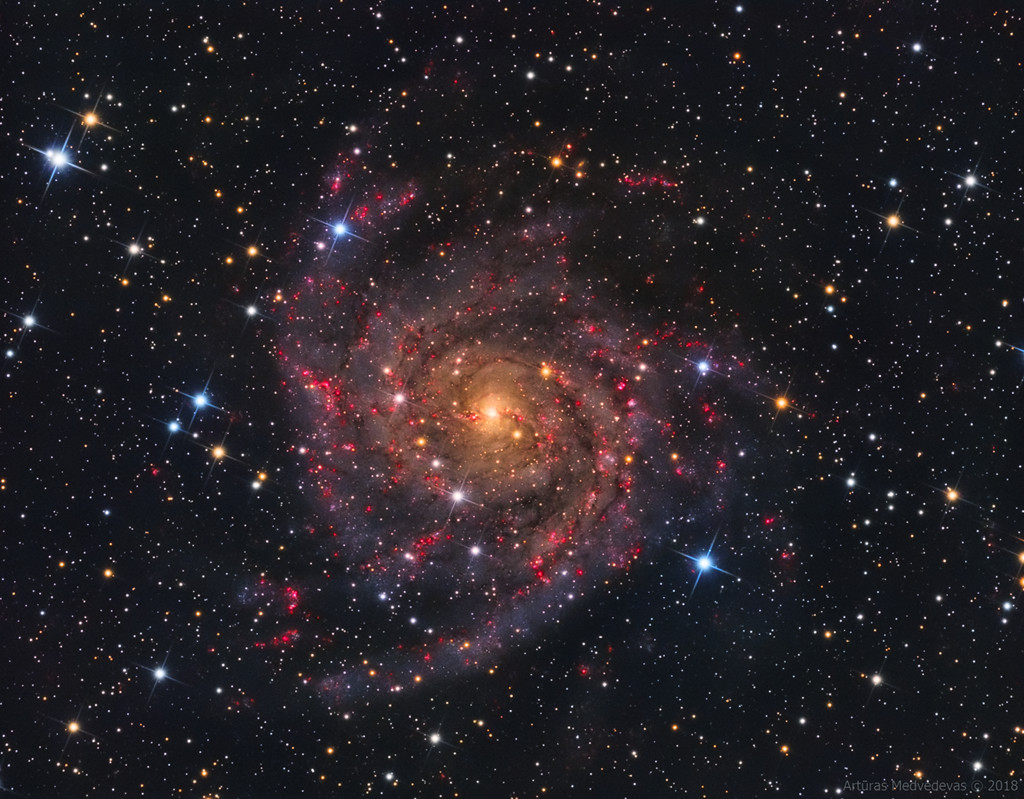
Image Credit & Copyright: Arturas Medvedevas
Explanation: Similar in size to large, bright spiral galaxies in our neighborhood, IC 342 is a mere 10 million light-years distant in the long-necked, northern constellation Camelopardalis. A sprawling island universe, IC 342 would otherwise be a prominent galaxy in our night sky, but it is hidden from clear view and only glimpsed through the veil of stars, gas and dust clouds along the plane of our own Milky Way galaxy. Even though IC 342's light is dimmed and reddened by intervening cosmic clouds, this sharp telescopic image traces the galaxy's own obscuring dust, young star clusters, and glowing pink star forming regions along spiral arms that wind far from the galaxy's core. IC 342 may have undergone a recent burst of star formation activity and is close enough to have gravitationally influenced the evolution of the local group of galaxies and the Milky Way.
14/01/2019
Science & Technology - Astronomy picture of the day - 2019 January 14 : Meteor and Milky Way over the Alps
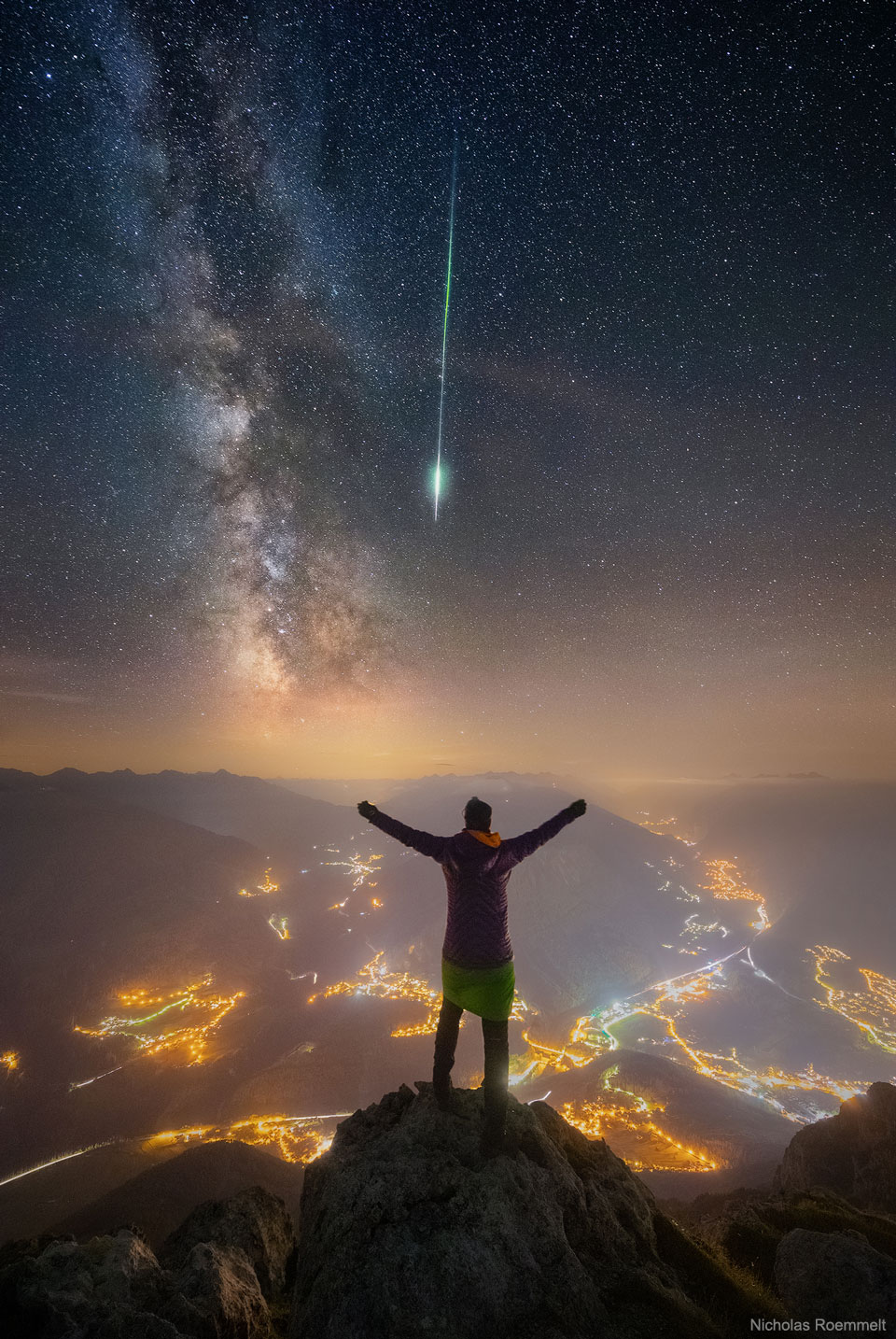
Explanation: Now this was a view with a thrill. From Mount Tschirgant in the Alps, you can see not only nearby towns and distant Tyrolean peaks, but also, weather permitting, stars, nebulas, and the band of the Milky Way Galaxy. What made the arduous climb worthwhile this night, though, was another peak -- the peak of the 2018 Perseids Meteor Shower. As hoped, dispersing clouds allowed a picturesque sky-gazing session that included many faint meteors, all while a carefully positioned camera took a series of exposures. Suddenly, a thrilling meteor -- bright and colorful -- slashed down right next the nearly vertical band of the Milky Way. As luck would have it, the camera caught it too. Therefore, a new image in the series was quickly taken with one of the sky-gazers posing on the nearby peak. Later, all of the images were digitally combined.
Ciência e Tecnologia - Cientistas demonstram que nossa 'alma' não morre: ela retorna ao universo
Cientistas acreditam ter desenvolvido uma teoria que esclarece algo sobre a misteriosa natureza da consciência - ou "alma"-, seu mecanismo no cérebro e, quem sabe, seu destino final após a morte.
Desde 1996, o Dr. Stuart Hameroff, emérito do Departamento de Anestesiologia e Psicologia e diretor do Centro de Estudos da Consciência, da Universidade do Arizona, junto com Sir Roger Penrose, físico matemático da Universidade de Oxford, desenvolvevem uma Teoria Quântica da Consciência, que define que a alma fica alojada em microtúbulos das células cerebrais.
"A origem da consciência reflete o nosso lugar no Universo, a natureza de nossa existência. Será que a consciência evoluiu de complexas operações computacionais entre os neurônios do cérebro, como a maioria dos cientistas afirmam? Ou a consciência, em algum sentido, esteve aqui o tempo todo, como as abordagens espirituais afirmam?" questionaram Hameroff e Penrose em uma revisão da sua teoria. "Isso abre uma potencialCaixa de Pandora, mas nossa teoria acomoda ambos os pontos de vista", acrescentam.
As experiências da consciência seriam um efeito da gravidade quântica nesses microtúbulos, que atuam como canais para a transferência da informação responsável pela consciência. “Quando o coração para de bater, o sangue para de correr e os microtúbulos perdem seu estado quântico. A informação quântica nos microtúbulos não é destruída, não pode ser destruída. Ela é simplesmente distribuída e dissipada pelo Universo”, explica Hameroff.
Fonte: ScienceDirect
13/01/2019
Science & Technology - Astronomy picture of the day - 2019 January 13 : "Tycho's Supernova Remnant in X-ray"
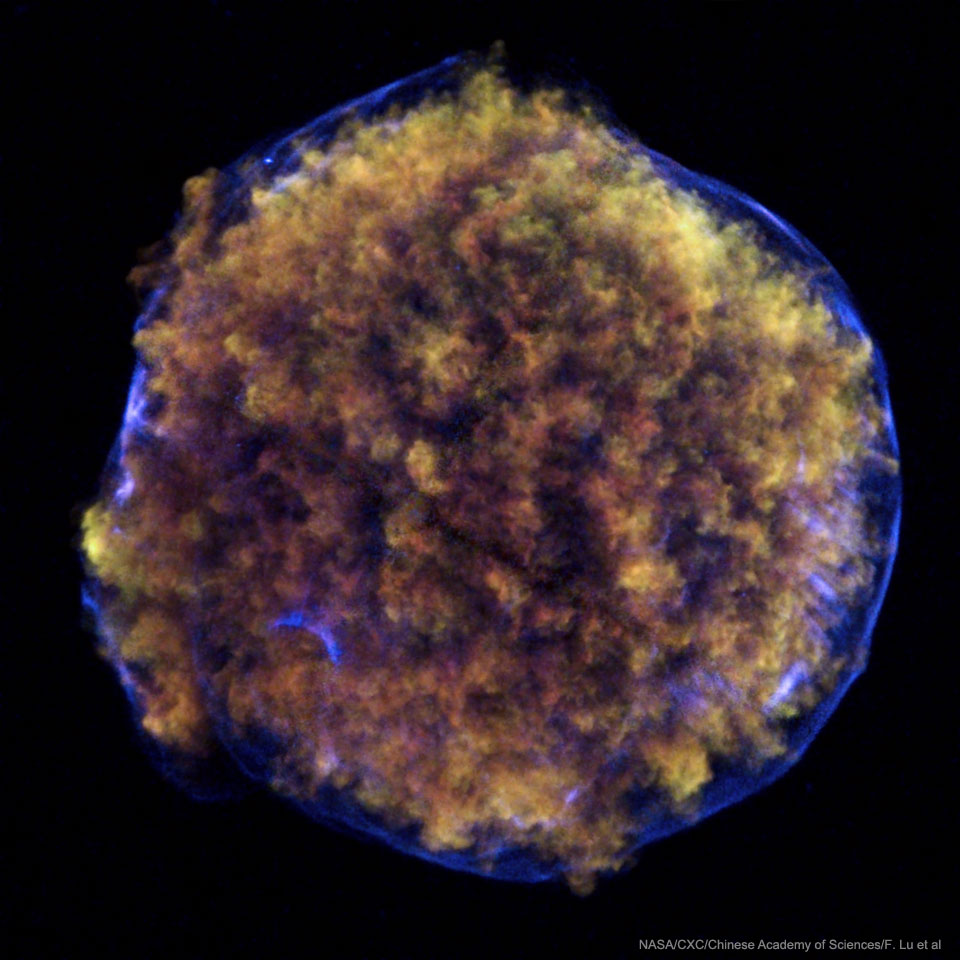
Image Credit: NASA / CXC / F.J. Lu (Chinese Academy of Sciences) et al.
Explanation: What star created this huge puffball? What's pictured is the hot expanding nebula of Tycho's supernova remnant, the result of a stellar explosion first recorded over 400 years ago by the famous astronomer Tycho Brahe. The featured image is a composite of three X-ray colors taken by the orbiting Chandra X-ray Observatory. The expanding gas cloud is extremely hot, while slightly different expansion speeds have given the cloud a puffy appearance. Although the star that created SN 1572, is likely completely gone, a star dubbed Tycho G, too dim to be discerned here, is thought to be a companion. Finding progenitor remnants of Tycho's supernova is particularly important because the supernova is of Type Ia, an important rung in the distance ladder that calibrates the scale of the visible universe. The peak brightness of Type Ia supernovas is thought to be well understood, making them quite valuable in exploring the relationship between faintness and farness in the distant universe.
12/01/2019
Science & Technology - Astronomy picture of the day, 2019 January 12 - Milky Way Falls

Image Credit & Copyright: Yuri Beletsky (Carnegie Las Campanas Observatory, TWAN)
Explanation: It can be the driest place on planet Earth, but water still flows in Chile's Atacama desert, high in the mountains. After discovering this small creek with running water, the photographer returned to the site to watch the Milky Way rise in the dark southern skies, calculating the moment when Milky Way and precious flowing water would meet. In the panoramic night skyscape, stars and nebulae immersed in the glow along the Milky Way itself also shared that moment with the Milky Way's satellite galaxies the Large and Small Magellanic clouds above the horizon at the right. Bright star Beta Centauri is poised at the very top of the waterfall. Above it lies the dark expanse of theCoalsack nebula and the stars of the Southern Cross.
Inscription à :
Commentaires (Atom)
ASTRONOMY - Sunset Solstice over Stonehenge
2025 December 22 Sunset Solstice over Stonehenge Image Credit & Copyright: English Heritage , Josh Dury Explanation: Yesterday the Su...
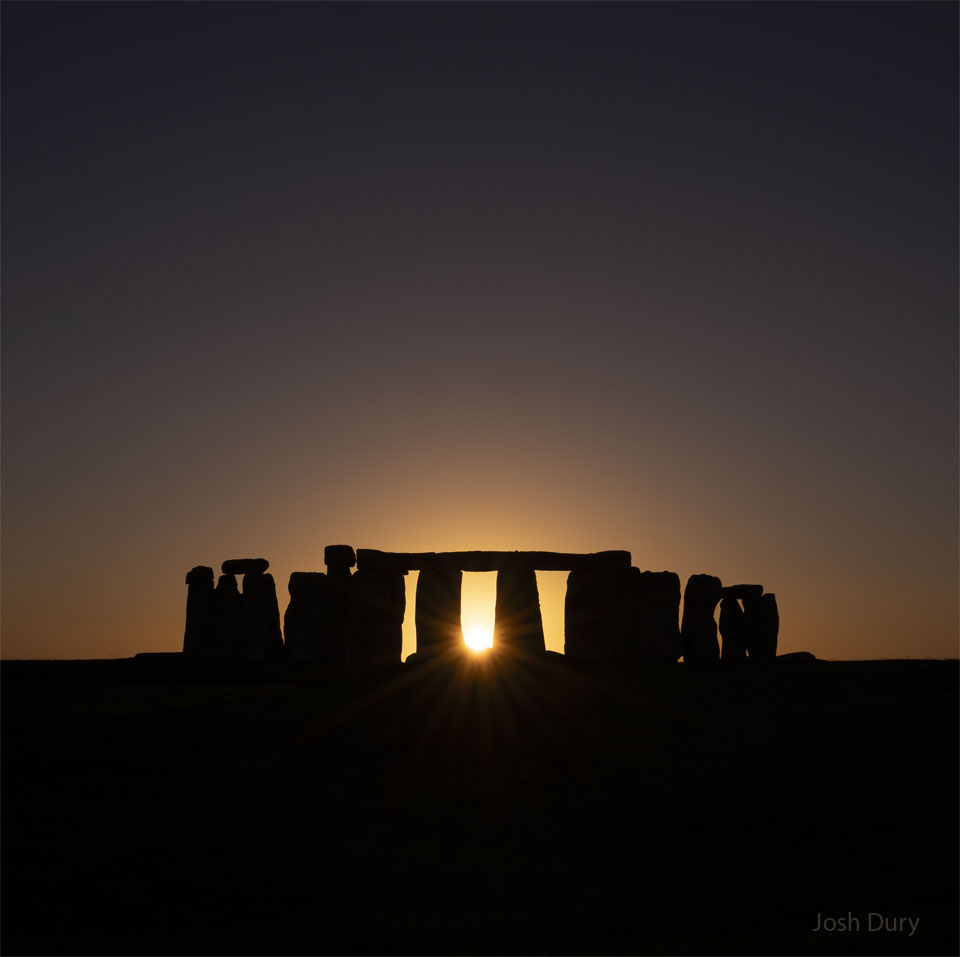
-
2022 September 26 All the Water on Planet Earth Illustration Credit: Jack Cook, Adam Nieman, Woods Hole Oceanographic Institution ; Data ...
-
2025 May 11 The Surface of Venus from Venera 14 Image Credit: Soviet Planetary Exploration Program , Venera 14 ; Processing & Copyri...
